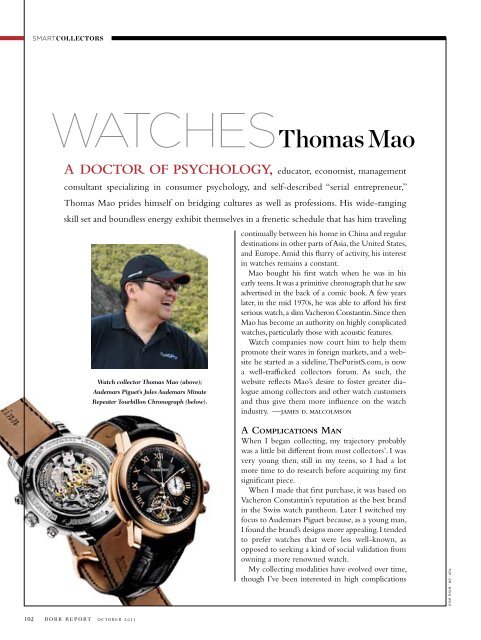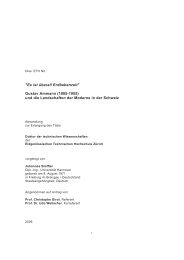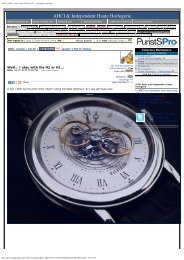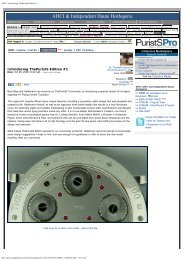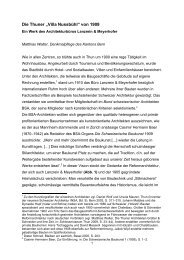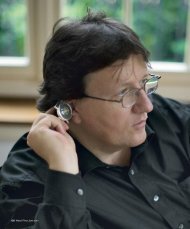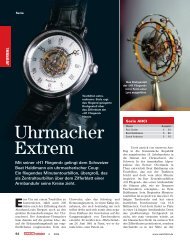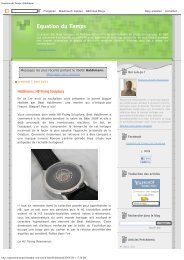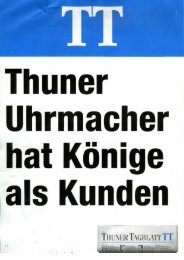watchesThomas Mao - Haldimann Horology
watchesThomas Mao - Haldimann Horology
watchesThomas Mao - Haldimann Horology
You also want an ePaper? Increase the reach of your titles
YUMPU automatically turns print PDFs into web optimized ePapers that Google loves.
smart collectors<br />
<strong>watchesThomas</strong> <strong>Mao</strong><br />
A doctor of psychology, educator, economist, management<br />
consultant specializing in consumer psychology, and self-described “serial entrepreneur,”<br />
Thomas <strong>Mao</strong> prides himself on bridging cultures as well as professions. His wide-ranging<br />
skill set and boundless energy exhibit themselves in a frenetic schedule that has him traveling<br />
continually between his home in China and regular<br />
destinations in other parts of Asia, the United States,<br />
and Europe. Amid this flurry of activity, his interest<br />
in watches remains a constant.<br />
<strong>Mao</strong> bought his first watch when he was in his<br />
early teens. It was a primitive chronograph that he saw<br />
advertised in the back of a comic book. A few years<br />
later, in the mid 1970s, he was able to afford his first<br />
serious watch, a slim Vacheron Constantin. Since then<br />
<strong>Mao</strong> has become an authority on highly complicated<br />
watches, particularly those with acoustic features.<br />
Watch companies now court him to help them<br />
promote their wares in foreign markets, and a website<br />
he started as a sideline, ThePuristS.com, is now<br />
a well-trafficked collectors forum. As such, the<br />
Watch collector Thomas <strong>Mao</strong> (above); website reflects <strong>Mao</strong>’s desire to foster greater dialogue<br />
among collectors and other watch customers<br />
Audemars Piguet’s Jules Audemars Minute<br />
Repeater Tourbillon Chronograph (below). and thus give them more influence on the watch<br />
industry. —james d. malcolmson<br />
A Complications Man<br />
When I began collecting, my trajectory probably<br />
was a little bit different from most collectors’. I was<br />
very young then, still in my teens, so I had a lot<br />
more time to do research before acquiring my first<br />
significant piece.<br />
When I made that first purchase, it was based on<br />
Vacheron Constantin’s reputation as the best brand<br />
in the Swiss watch pantheon. Later I switched my<br />
focus to Audemars Piguet because, as a young man,<br />
I found the brand’s designs more appealing. I tended<br />
to prefer watches that were less well-known, as<br />
opposed to seeking a kind of social validation from<br />
owning a more renowned watch.<br />
My collecting modalities have evolved over time,<br />
though I’ve been interested in high complications<br />
top: Dr. Ming Woo<br />
102 robb report october 2011
smart collectors ✵ thomas mao<br />
almost as long as I’ve been interested in timepieces. As a<br />
young guy, I was attracted by high mechanics, by awesome<br />
metal finishing, by mechanical function, so therefore I preferred<br />
chronographs. One of the many reasons I now like<br />
minute repeaters is because they’re the most romantic complication,<br />
versus a tourbillon, which is an intellectual complication.<br />
Beat <strong>Haldimann</strong> makes the<br />
purest expression of the tourbillon by<br />
cutting each central tourbillon cage<br />
by hand, the old-fashioned way.<br />
It has been a little bit haphazard<br />
jumping from one complication line<br />
to another, but I have had the financial<br />
ability to acquire whatever has<br />
moved me at the moment.<br />
Collectors<br />
and Collectibles<br />
There are collectibles, and then there<br />
are collectors. The two terms sound<br />
and look similar, but they represent<br />
two completely different concepts.<br />
True collectors see the intrinsic<br />
value of whatever it is they’re collecting,<br />
and the market price is just the toll they have to pay<br />
to get whatever it is they’re after.<br />
Collectibles are objects that people seek out nearly always<br />
with the goal of monetary appreciation. Collectibles are<br />
viewed as repositories of value. “If I buy this,” people say of<br />
collectibles, “in the future I’ll have something that’s going to<br />
be worth 50 percent more or three times more than it is now.”<br />
Collectors don’t seek out collectibles. What they collect<br />
more often than not fulfills something other than a desire<br />
for monetary appreciation. Collectors measure their return<br />
on investment in terms of personal satisfaction and pride of<br />
ownership, and those outweigh any monetary appreciation.<br />
They don’t buy items to sell them; they buy them to own<br />
them. Collectors do not collect collectibles a priori; the<br />
items they collect become collectibles after the fact.<br />
The punters, the speculators, they’re the ones who measure<br />
their ROI in terms of market appreciation, because they<br />
buy to sell. They watch collectors and see what they seek out.<br />
Thus you end up having items such as the triple-sealed<br />
Patek Philippes, which are constantly changing hands and<br />
are never appreciated as great timepieces. Because nobody<br />
ever actually values the real essence of these watches,<br />
there’s little that’s more offensive to my collector’s mentality<br />
than a triple-sealed Patek Philippe.<br />
Value Should Be Subjective<br />
The rose-colored-glasses view of the world holds that you<br />
can gain access to the most coveted watches by developing<br />
good relationships with the authorized dealers who usually<br />
<strong>Mao</strong> is a fan of the Beat <strong>Haldimann</strong> tourbillon<br />
(above) and has long preferred watches produced<br />
by Audemars Piguet (below).<br />
get first crack at the best pieces. This is what the watch<br />
industry wants you to believe. But the reality is if you’re the<br />
best customer of an authorized dealer, he won’t necessarily<br />
call you first. Instead, he’ll contact people who might<br />
become his new customers. Such a dealer deserves no loyalty.<br />
It is best to define for yourself what intrinsic value is. That’s<br />
something collectors can do only for<br />
themselves. Depending on the individual<br />
collector, a watch’s intrinsic<br />
value might lie in its patrimony, its<br />
finishing, its reliability.<br />
The prices of some great, classic<br />
column-wheel-based lateral-clutch<br />
chronographs represent tremendous<br />
value, because traditional chronographs<br />
are not in vogue today. Collectors can<br />
make some of the most raving, incredible<br />
deals for Audemars Piguet sonneries,<br />
which are many times more<br />
costly and difficult to make as a minute<br />
repeater. When you can pick up<br />
an AP quarter repeater sonnerie with<br />
provenance for $65,000, that’s like<br />
buying an Aston Martin for $25,000.<br />
The deals are where the widest deltas exist between<br />
intrinsic value and market value, the latter of which is usually<br />
defined by the punters and speculators. Collectors who<br />
know what they’re after can capture that value.<br />
104 robb report october 2011


